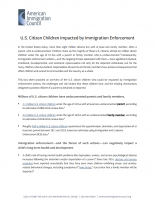- Fact Sheet
The Impact of Immigrant Women on America’s Labor Force
Published
There are nearly 12 million immigrant (foreign-born) women workers in the United States today, comprising just over 7 percent of the total labor force. According to data from the 2015 American Community Survey (ACS), large numbers of immigrant women workers are found at both ends of the educational spectrum; just over one-third have a bachelor’s degree or more, while more than two-fifths have a high-school diploma or less. This diverse educational profile is reflected in the wide range of jobs they fill, many of which are lower paid yet vital to the functioning of the U.S. economy. Immigrant women play crucial roles in healthcare as nursing, psychiatric, and home health aides and as registered nurses. Many also work in housekeeping and childcare. In addition, immigrant women workers comprise a large share of the labor force in a variety of service and light industrial occupations. Although they hail from every corner of the globe, the overwhelming majority of immigrant women workers come from Latin American and Asian countries—primarily Mexico, the Philippines, China, India, and Vietnam. Many of the women who work at the lower end of the income spectrum are unauthorized, which severely hampers their upward mobility.
Immigrant Women Workers as a Whole
Over 7 percent of all U.S. workers are immigrant women
Approximately 11.8 million immigrant women accounted for 7.3 percent of the U.S. labor force in 2015. By way of comparison, native-born men were 43 percent of the total workforce, native-born women 40.1 percent, and immigrant men 9.6 percent (Figure 1).
Figure 1: U.S. Labor Force by Nativity and Sex, 2015
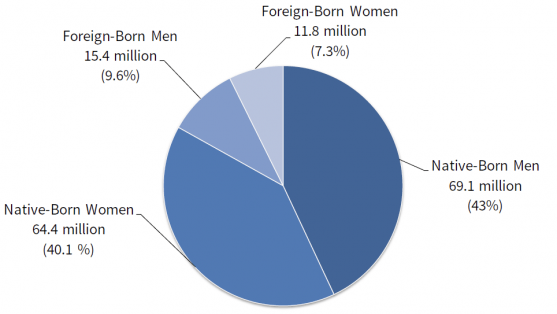
Source: 2015 American Community Survey, PUMS.
Immigrant and native-born women participate in the labor force at nearly the same rate
Immigrant women participate in the labor force at a lower rate than either native-born or immigrant men, but at a rate only slightly below that of native-born women. In 2015, the labor force included 55.6 percent of immigrant women age 16 and older, compared to 77.1 percent of immigrant men, 66.5 percent of native-born men, and 58.5 percent of native-born women (Figure 2).
Figure 2: Labor Force Participation Rates of Foreign- and Native-Born Men and Women, 2015
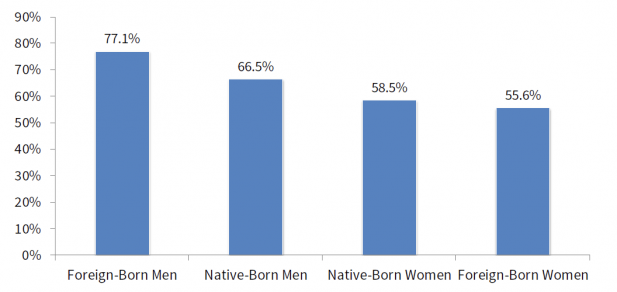
Source: 2015 American Community Survey, PUMS.
Just over half of immigrant women workers are from Latin America; nearly one-third are from Asia
Just over half (50.8 percent) of immigrant women workers were from Latin America as of 2015, while roughly one-third (31.3 percent) were from Asia, 10.4 percent from Europe, and 5.2 percent from Africa (Figure 3).
Figure 3: Foreign-Born Women Workers by Region of Birth, 2015
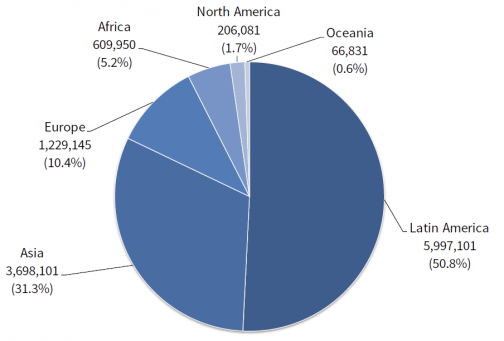
Source: 2015 American Community Survey, PUMS.
Immigrant women from Africa have the highest rate of labor-force participation
Among immigrant women, those from Africa had the highest rate of labor-force participation (65.6 percent) in 2015, followed by those from Latin America (56.7 percent), Asia (55 percent), and Europe (49.6 percent) (Figure 4).
Figure 4: Labor Force Participation Rates of Foreign-Born Women by Region of Birth, 2015
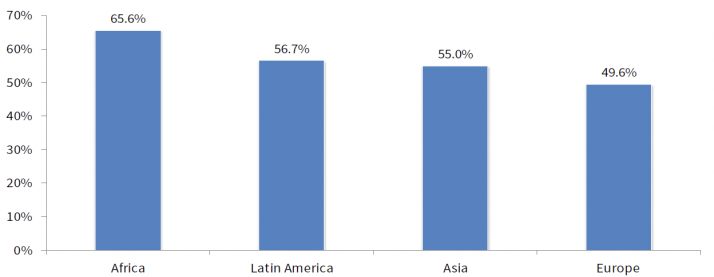
Source: 2015 American Community Survey, PUMS.
The largest numbers of immigrant women workers are from Mexico, the Philippines, and China
Of the total number of immigrant women workers living in the United States in 2015, the largest share (2.8 million, or 23.8 percent) were from Mexico, followed by 752,648 from the Philippines (6.4 percent), 570,378 from China (4.8 percent), 559,779 from India (4.7 percent), and 424,110 from Vietnam (3.6 percent) (Figure 5).
Figure 5: Foreign-Born Women Workers by Country of Origin, 2015
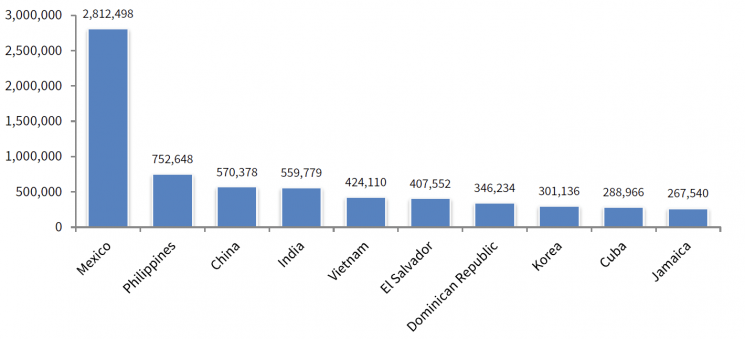
Source: 2015 American Community Survey, PUMS.
Immigrant women workers are found across the educational spectrum
As of 2015, 33.6 percent of immigrant women workers had a bachelor’s degree or more, while 42.8 percent had a high-school diploma or less. Nearly one-quarter (23.7 percent) had some college education short of a bachelor’s degree (Figure 6).
Figure 6: Foreign-Born Women Workers by Educational Attainment, 2015
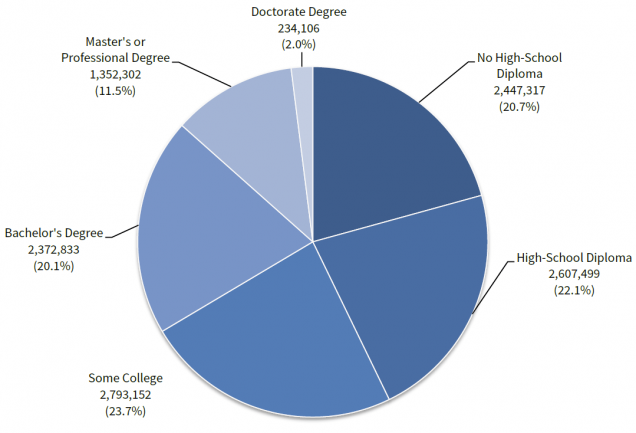
Source: 2015 American Community Survey, PUMS.
Two-fifths of immigrant women workers earn low wages
One-fifth (20.4 percent) of immigrant women workers earned poverty-level wages in 2015 ($11,770 per year or less)—significantly higher than the 13.5 percent poverty rate of the U.S. population as a whole. In addition, a little over one-fifth (21.8 percent) were earning annual wages that did not qualify as poverty-level by federal standards, but were very low nonetheless (above $11,770, but no more than $20,000). Only 5 percent earned more than $100,000 per year (Figure 7). However, it is important to note that low-wage immigrant women workers are providing essential labor in key sectors of the economy, including healthcare, hospitality, and food service.
Figure 7: Earnings Distribution of Foreign-Born Working Women, 2015
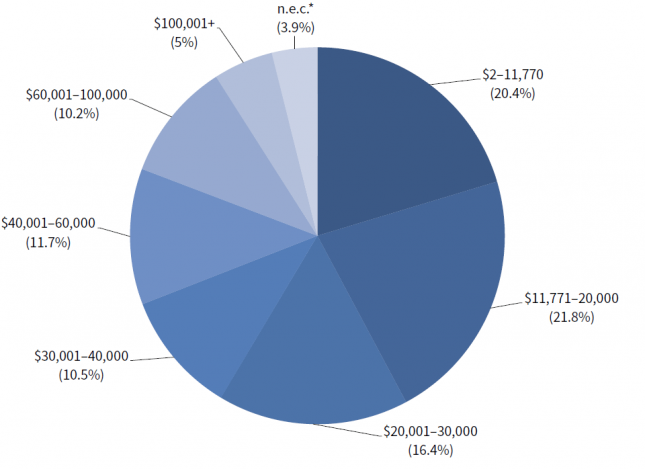
Source: 2015 American Community Survey, PUMS.
*not elsewhere classified.
Maids and housekeepers account for the largest number of immigrant women workers, followed by nursing, psychiatric, and home health aides
The largest numbers of immigrant women workers (882,663) were maids and housekeepers in 2015. Approximately 501,740 were nursing, psychiatric, and home health aides; followed by cashiers (480,391); registered nurses (454,057); and janitors and building cleaners (364,494) (Figure 8).
Figure 8: Top Occupations of Foreign-Born Women Workers, 2015
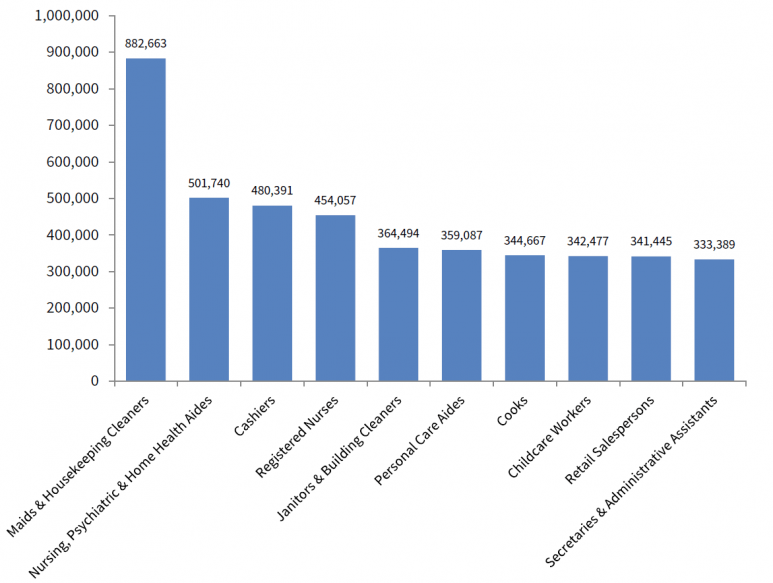
Source: 2015 American Community Survey, PUMS.
Immigrant women workers are large shares of the labor force in many service and light industrial occupations
In 2015, immigrant women comprised more than half (51.5 percent) of all workers grading and sorting agricultural products, 47.1 percent of personal appearance workers, 42 percent of maids and housekeepers, 39.5 percent of textile and garment pressers, and 39.5 percent of sewing machine operators (Figure 9). These figures underscore the extent to which immigrant women workers have filled vital economic niches, not only in service occupations such as housekeeping, but in light industry as well.
Figure 9: Female Foreign-Born Share of Labor Force, Top 10 Occupations, 2015
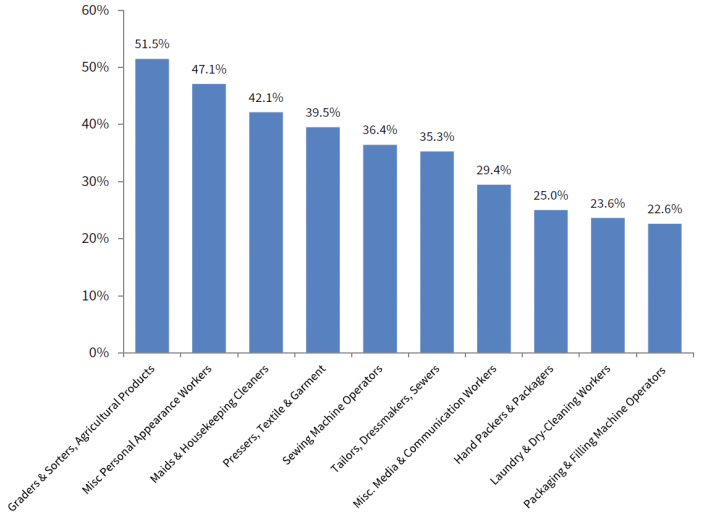
Source: 2015 American Community Survey, PUMS.
Low-Wage Immigrant Women Workers
More than three-fifths of low-wage immigrant women workers are from Latin America
Immigrant working women tend to fill economically essential yet poorly paid jobs. In fact, 42 percent of immigrant women workers were concentrated in low-wage occupations in 2015, defined as those paying $20,000 or less per year. More than three-fifths (62 percent) of low-wage immigrant women workers were from Latin America, while just under a quarter (24.2 percent) were from Asia, 7.4 percent from Europe, and 4.7 percent from Africa (Figure 10).
Figure 10: Low-Wage Foreign-Born Women Workers, by Region of Birth, 2015

Source: 2015 American Community Survey, PUMS.
The largest number of low-wage immigrant women workers are from Mexico, followed by El Salvador and China
The largest number of low-wage immigrant women workers (1.7 million) were from Mexico as of 2015, followed by El Salvador (221,333), China (215,154), the Philippines (199,519), and Vietnam (179,842) (Figure 11).
Figure 11: Low-Wage Foreign-Born Working Women by Country of Birth, 2015
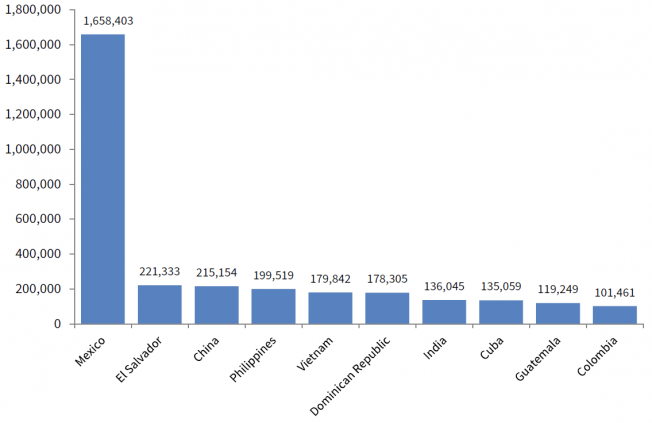
Source: 2015 American Community Survey, PUMS.
Two-fifths of low-wage immigrant women workers lack a high-school diploma
One of the key barriers to upward mobility for many low-wage immigrant women workers is access to education. Two-fifths (39.9 percent) of low-wage immigrant women workers lacked a high-school diploma as of 2015; one-third (34.5 percent) had only a high-school diploma; fewer than one-fifth (17.9 percent) had some college education short of a degree, while only 7.7 percent had a bachelor’s degree or higher (Figure 12).
Figure 12: Low-Wage Foreign-Born Women Workers, by Educational Attainment, 2015
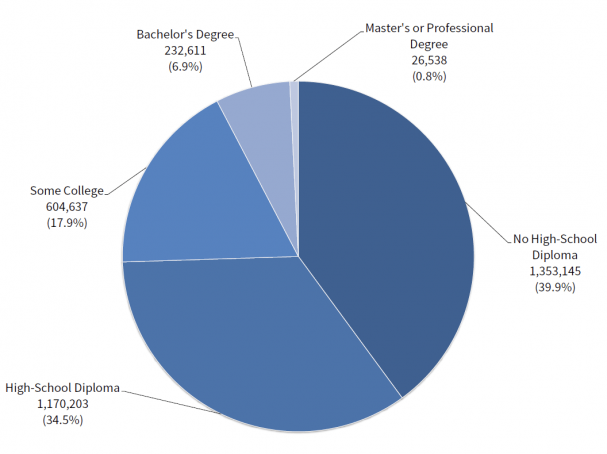
Source: 2015 American Community Survey, PUMS.
The greatest numbers of low-wage immigrant women workers are maids and housekeepers, cashiers, and personal care aides
The greatest number of low-wage immigrant women workers (534,918) worked as maids and housekeepers in 2015, followed by 296,320 as cashiers; 214,858 as personal care aides; 208,976 as cooks; and 205,114 as nursing, psychiatric, and home health aides (Figure 13).
Figure 13: Top Occupations of Low-Wage Foreign-Born Women Workers, 2015
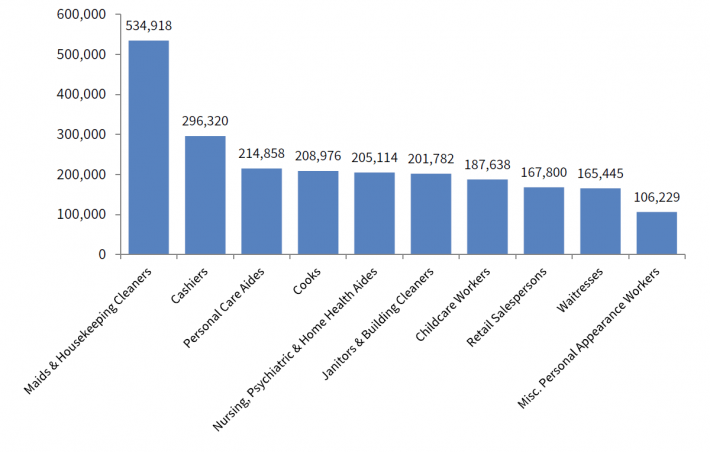
Source: 2015 American Community Survey, PUMS.
Large shares of low-wage immigrant women workers are found in service and light industrial occupations
In 2015, low-wage immigrant women workers comprised the highest share of all workers (40 percent) as graders and sorters of agricultural products, followed by personal appearance workers (31.8 percent), textile and garment pressers (31.6 percent), maids and housekeepers (31.4 percent), and sewing machine operators (25 percent) (Figure 14).
Figure 14: Female Low-Wage Foreign-Born Share of Labor Force, Top 10 Occupations, 2015
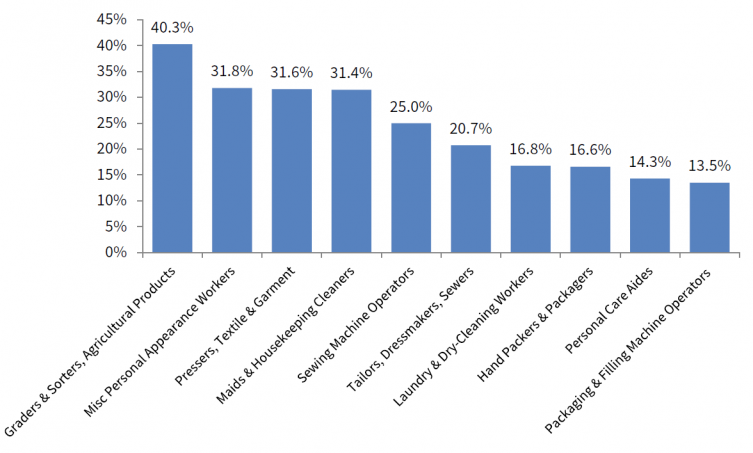
Source: 2015 American Community Survey, PUMS.

